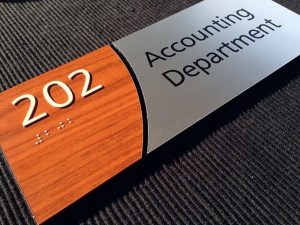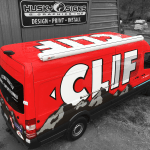We -the human race- are a dynamic global society in continuous motion. Mobility is essential to humankind, and this entails being able to easily travel from one place to another in the fastest and safest way possible. Even if or when you are not familiar with the run.
Here is what happens when there are insufficient wayfinding system signs. Examples: late to an appointment because you couldn’t find the office or correct floor, missing a train or flight because you were at the wrong gate, or missing an exit on the highway. With proper, simple, clear and visible wayfinding signs, you would have been able to quickly find the correct floor or office in the building, the exit lane on the highway or the gate at the train station, in a natural way.
Wayfinding makes our lives easier in so many ways that sometimes it is hard even to picture it. It has been around us since the early men. However, back then, it was a matter of life and death. To survive, they would mark their path through the mountain or jungle to safe shelter and remember where to find food or freshwater sources.
Today, wayfinding is used everywhere, with specific purposes from guiding you to your destination, to informing particular and essential data.
Importance of Wayfinding in Our Daily Lives
Wayfinding systems have evolved hand in hand with the human race, helping us survive and become what we are today. They provide essential benefits that go beyond leading the path from point A to point B. Wayfinding signs are everywhere; they can be found in hospitals, subway stations, roads, libraries, stadiums, national parks, city buildings, and virtually everywhere. If we were not able to see ourselves oriented in unknown environments, we wouldn’t be able to coexist as a society. It would be a total disaster.
You can find multiple definitions to describe wayfinding. But most of the designers and signage experts explain it as consistent use of tools and processes to organize particular sensory cues from the external environment. That helps to find the path and reach a destination quickly. It is the act of using all your visual and sensorial elements in your surroundings, including speeches, word, print, signs, architecture, landscape, even smells, to orient yourself in physical space and navigate from place to place.
Wayfinding Evolution
The evidence of wayfinding techniques in the early days is undeniable. Early prehistoric and indigenous cultures have provided solid proof of how smart they were using different elements in their surroundings, marking their path and special places. But also a tangible reference of how much it has evolved through the centuries.
Canadian’s famous Inuksuk are great examples of this. Inuksuks are figures made of piled stones or boulders constructed to communicate with humans and find the path throughout the Arctic. The Inuits build these figures as hunting and navigational aids, coordination points, camps, hunting grounds, fishing places, sacred and veneration areas, message centers, and food sources, among other many other practical functions. In Central America, Costa Rican archeologists and anthropologists explain how the famous gigantic rock spheres were found in strategic areas. Theories stated that they were used to mark important ritual and sacred places or to show the hierarchy of their leaders.
These visual communication techniques evolved through different states and forms, especially after we were able to conquer the seas. Sailing navigation gave travelers the possibility to move beyond unexplored areas, finding completely unmarked and mislabel routs and giving birth to maps. Maps provided a significant breakthrough allowing explorers to extract spatial information quickly and to anticipate what was to come.
Of course, the automotive industry gave a considerable boost to the wayfinding evolution, especially in urban planning. As we start driving the urgent need of regulating our roads became vital. In 1970, as the Society for Environmental Graphic Design was found, the task of studying the best way to orient and guide the public through spaces was assumed. The mission was to create proper sign systems for our roads.
However, navigational aids do not become an exclusive outdoor and public requirement or tool. Developers of office buildings, shopping malls, and other pedestrian spaces, also found amazing benefits creating indoor wayfinding signs, that enhance visitors’ experience. By the mid-80s, businesses had already understood the power of graphic design, visual communication, and wayfinding in the corporate world and retail projects. At this moment, designers were efficiently arranging train stations, State buildings, museums, theme parks, and business centers, exploiting visual elements to enhance and convey important messages.
Wayfinding Today
Cities are becoming more significant every day. The world is more globalized, and the need for aiding to move large numbers of people from one place to another is quickly growing and expanding. Today, the world has become smaller, and people of all nationalities must be able to understand directions to safely and efficiently move in substantial public spaces. Therefore, visual communication is becoming standard and generalized to be easily understood.
Designers work hard to develop symbols that help non-natives find their gate, the bathrooms, and baggage claim in airports. Also, unique rooms and exhibit areas in museums, and or to indicate the exit and regulations in national parks, creating a global language.
Creating an Efficient Wayfinding System
Regardless of the type of business, building, facility, or project you manage, it is essential to integrate wayfinding systems to enhance the experience of your customers and visitors. The more familiar they are moving naturally through your building, the longer they will stay, and the easier it will be to accomplish your particular goals.
Types of Wayfinding Signs
Not all wayfinding signs are the same, work the same, nor provide the same elements. It is essential to know and understand the different types of wayfinding signs there are to build an efficient wayfinding system. Each one of them has particular properties and features that if well applied, can boost your specific goals.
Most visual and sign designer experts classify wayfinding signs in identification, directional, informational, and regulatory signs. Depending on your project, building, exterior, and interior visual elements at your disposal and specific goals, one wayfinding sign could work better than the other. Nevertheless, a successful and efficient wayfinding system usually uses all four types, accurately complementing each other.
Directional Signage
Directional signs are among the most commonly known type of wayfinding signage. This type of signage is pretty much straight forward and usually has high international recognition. It is easy for people to understand, regardless of their nationality. These signs keep people moving toward their final destination.
They are usually found anywhere someone might need guidance, and often uses well known, easy to understand symbols like arrows. They can be used wherever it is crucial to guide people like national parks, hospitals, or airports accurately.
Identification Signage
Contrary to directional signs, identification signs let you know that you have arrived at your destination, instead of providing guidance and directions. They can be commonly found, for instance, outside the door of an office, displaying the worker’s name. They can be the name of a shop on exterior commercial signage or the campsite symbol on a national park. Its objective is to ensure visitors they are at the right place.
Identification signs must be clear and straightforward of where you are and what is to be found at the exact spot. They can be the name of the conference room, the floor number or terminal letter, regardless of the final message it should be clear and distinct.
Regulatory Signage
Many are not even aware that this type of signage is considered a wayfinding sign, but regulatory signs are a vital part of any efficient wayfinding system. They are the critical element in creating and keeping a safe environment for your visitors.
Regulatory signs ensure that visitors understand the rules, requirements, limitations, and indications that need to be followed and understood. For instance: making people aware of any potential hazard, parking in a particular spot, permits required to be on-site, smoking or non-smoking area, or if animals are allowed. These simple examples may sound easy to handle, but people won’t know unless you make it clear.
Regulatory signs have to be easy to understand, clear, and visible. They are commonly found in airports, national parks, hospitals, libraries, and pretty much any public space.
Informational Signage
This type of signage is more about providing essential information to travelers and users to improve their experience and to satisfy their expectations. Informational signs give specific details about your destination. For instance: alert of dangers on the highways, free spaces in parking lots, opening hours at restaurants, Internet access in hotels, or what you can and cannot take in flights and airports.
Informational signs are great to boost the visitors’ experience and strengthen security in specific areas.
Now that you have a better idea of the different types of wayfinding signs available, you can start considering the best kind and combination that suits your goals. It is crucial to take into account several designing steps and tips to succeed in your wayfinding project.
Designing Effective Wayfinding Signage
Creating eye-catching and striking signage, that complies with the goals previously established, is a hard task. When it comes to productive wayfinding purposes, it is an art form that must be carried by professionals. What is interesting about wayfinding signage is that the better designed it is, the less you will notice it.
Effective wayfinding signs are almost invisible when designed accurately. They are an attractive and useful visual element that your brain will catch in a blink of an eye, interpreting its meaning, naturally following the directions or indications.
Therefore, they need to be clear when conveying information while using and organizing visual elements for the visitor’s easy navigation. To achieve this, you must take into consideration several variables that must harmoniously work together.
Consider Your Target Audience
Your first step is keeping in mind your customers and visitors preferences and profile. Your wayfinding system should assist users and visitors, providing accurate answers to their needs. Take into consideration your staff, customers, partners, and any other visitors that interact within your space. Talk to them and learn about their needs and suggestions.
This process is beneficial, especially when your visitors have very different characteristics, like different languages, age, particular requirement limitations, or disability.
Know Your Area
It is vital to visit the location where you intend to install and design your wayfinding system. It might even take several visits to be able to pick up and learn everything you need and can use from your location. Walk around and survey, pay attention to your customers and staff, and put yourself in their shoes.
Never make assumptions or take anything for granted. Include all places, even those that seem easy to navigate. Consider landmarks and visual elements on your path. This can help to define your visitor’s decision points. These are the areas where a decision needs to be made, like going upstairs or downstairs, taking a right or left, exiting, and many more.
It is vital to remember your target audience and place your wayfinding signage in strategic areas where everyone can see it. At this point, it is also crucial to consider ADA signs regulations. Your wayfinding signs should comply with ADA regulations. Think of materials that are resistant to the weather and conditions it will be facing. Also, those that can provide unique features like particular texture and lighting that can help people with any impairment.
Wayfinding Design
Here is where the magic begins and when you have the chance to artistically arrange your visual elements to convey your message and direct your visitors. However, it is vital to keep it simple. Most of the designers will agree that your main goal in wayfinding is guiding visitors. But there is still plenty of room for creativity if it will boost your visitor’s navigating experience. However, try to keep it simple and practical. Keep it concise, clean, and bright.
Try to take advantage of universally known symbols, like arrows, bathroom, trash, and handicap symbols. These are great aids in areas where large masses of people from different cultures, nationalities, and languages interact, for example, airports and train stations, reducing the written language barriers. As it is said: A picture is worth a thousand words.
Nevertheless, when using symbols like arrows, it is vital to place them correctly. An arrow pointing somewhere in between can become a considerable problem for visitors who don’t know the area, making it confusing. Also, it is essential to make sure that they are mounted on the right wall and continuously maintaining and updating them. Sometimes routes or final locations change and outdated signs can do more harm than good.
Wayfinding signs have been part of us since the rise of the first civilizations becoming such an intrinsic and natural element that we hardly notice them. They are vital in any public space and can provide a wide range of benefits for commercial purposes. Contact Husky Creative today, and learn more about our fantastic wayfinding products.








